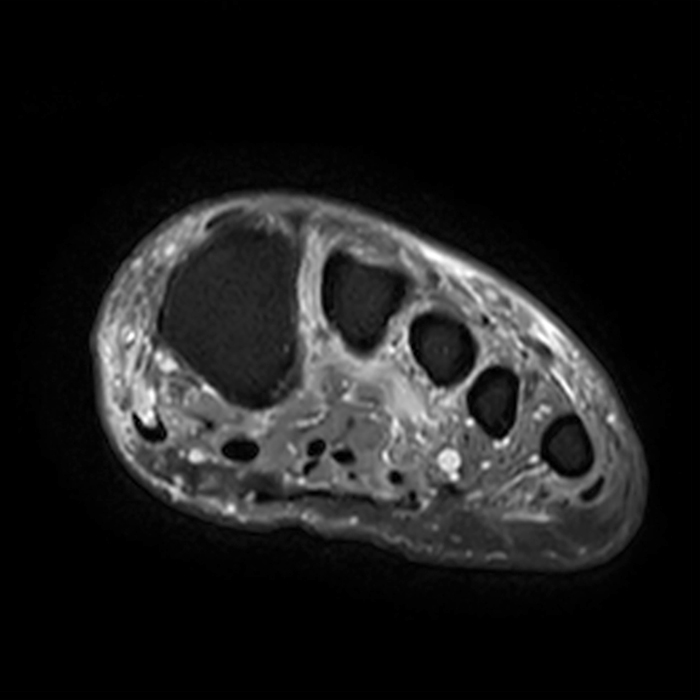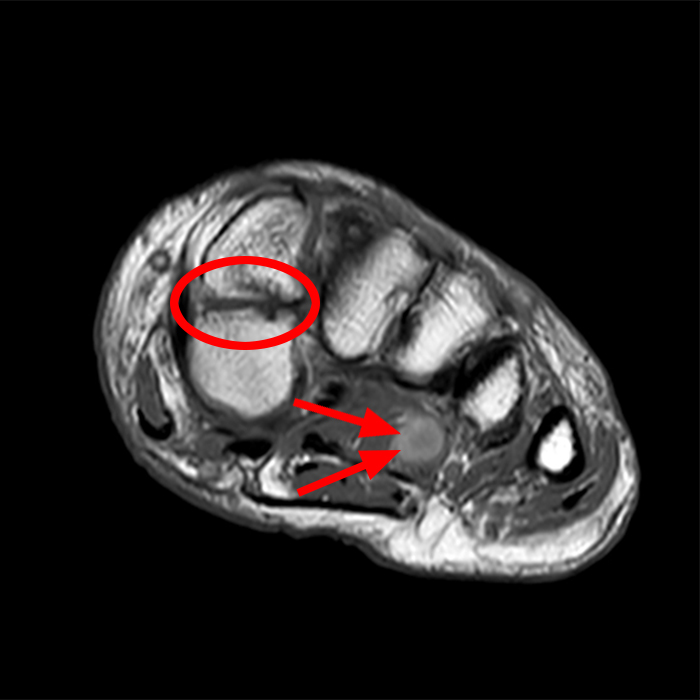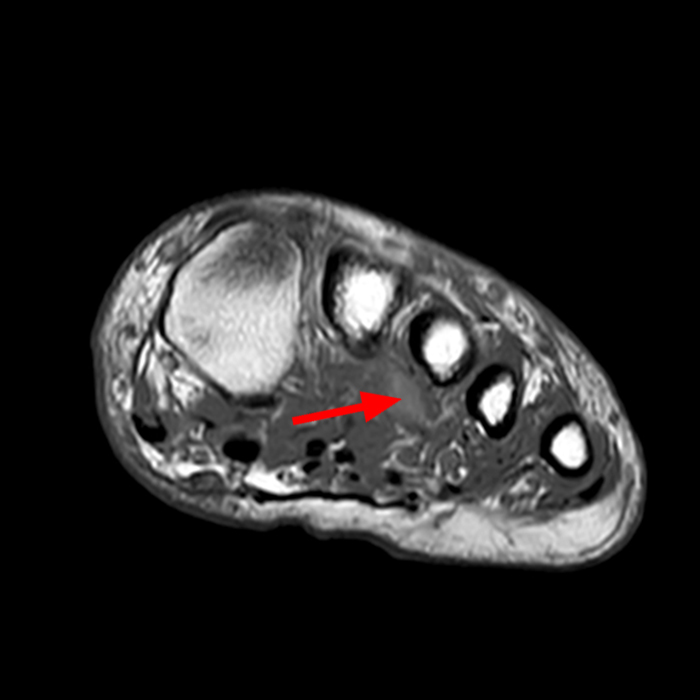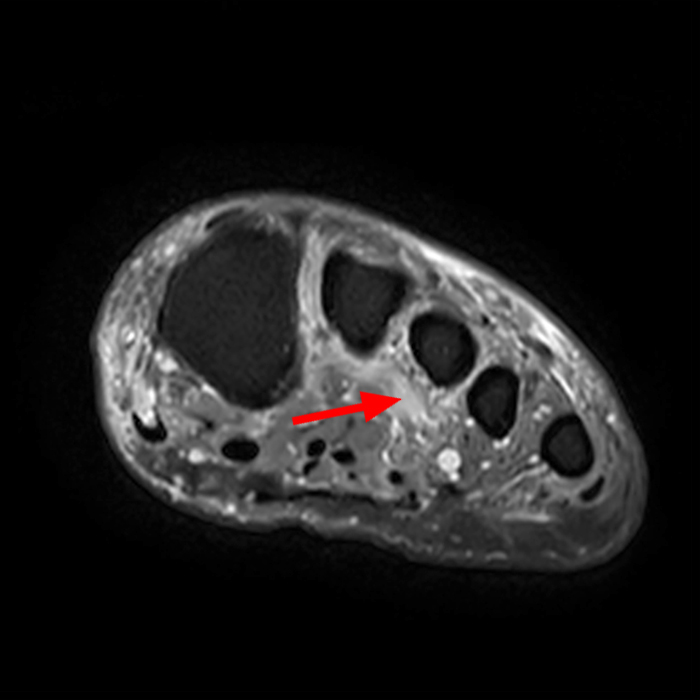Clinical History: A 67 year-old male complains of lateral foot pain without relief after injection and nonsteroidal anti-inflammatory medications. T1-weighted (1a) and T2- weighted (1b) coronal images at the midfoot-forefoot junction and the proximal forefoot (1c and 1d) are provided. What are the findings? What is your diagnosis?
Findings
Figure 2:
At the level of the midfoot-forefoot junction, the (2a) coronal T1-weighted image demonstrates a thrombosed distended lateral plantar vein with increased intraluminal signal (arrow) and an incidental bipartite medial cuneiform (oval). The (2b) coronal proton density fat-suppressed image demonstrates thrombus with increased signal within the distended lateral plantar vein (arrow) and perivascular edema (arrowheads). At the level of the proximal forefoot, the (2c) coronal T1-weighted image demonstrates high signal thrombus in the plantar arch (arrow) and the (2d) coronal proton density fat suppressed image shows high signal thrombus in the plantar arch (arrow).
Diagnosis
Plantar vein thrombosis.
Introduction
Plantar vein thrombosis is an uncommon diagnosis. The true incidence is unknown and is likely underdiagnosed because of the unfamiliarity with the entity. Predisposing factors for plantar vein thrombosis include trauma, paraneoplastic syndromes, recent surgery, abnormal clotting factors, airplane travel, oral contraceptives, HIV/AIDS and extended standing.1,2,3,4,5 The most common presentation is non-specific plantar pain and swelling.1,6 In a series of 22 patients, the thrombosed venous segments included lateral plantar veins 96%, medial plantar veins 41% and deep tibial veins 27%.1 In another study of twenty patients, the thrombosed venous segments included medial plantar veins 10%, lateral plantar veins 30%, plantar metatarsal veins 40% and plantar digital veins 20%.7 In our experience, the lateral plantar vein is the most commonly thrombosed plantar venous segment and concurrent involvement of the plantar arch and plantar metatarsal veins is common. (Fig. 3) The medial plantar veins are typically smaller and thrombosis is more difficult to appreciate.
Figure 3:
A sixty-four year old male presents with trauma and foot pain. A coronal T1-weighted image (3a) shows distension of the lateral plantar vein with high signal thrombus (arrow) interposed between the quadratus plantae (red asterisk) and flexor digitorum brevis muscle (blue asterisk) and the lateral plantar artery is adjacent to the lateral plantar vein (arrowhead). A coronal T1-weighted image (3b) more distally shows high signal thrombus in the plantar arch (arrow) deep to the oblique head of the adductor hallucis muscle (asterisk). A coronal proton density fat-suppressed image (3c) more distally shows high signal thrombus in the plantar fourth metatarsal vein (arrow) deep to the transverse head of the adductor hallucis muscle (arrowheads).
Anatomy
The venous anatomy of the foot is complex and highly variable. Many of the veins are unnamed and/or too small to resolve with conventional MRI examinations. Supine patient positioning and use of surface coils with padding can further compromise visualization of the foot veins. Anatomists and phlebologists have described many variations of the foot venous system and the following discussion is limited to the major plantar veins visualized with routine MRI examinations (Fig. 4). The plantar venous system begins at the level of the toes with vascular plexuses that drain into plantar digital veins and then into the plantar metatarsal veins. The plantar metatarsal veins drain into the plantar arch, which parallels the arterial arch and is at the level of the proximal forefoot.7 The plantar arch drains into the lateral and medial plantar veins that subsequently drain into the posterior tibial veins. There are numerous variations including duplication of plantar arch and medial and lateral plantar veins, vein to vein communications and communications with the superficial and dorsal venous systems.8
The plantar arch, plantar metatarsal veins and the medial and lateral plantar veins lie deep to plantar muscle groups. The medial plantar vein lies between the abductor hallucis and the flexor hallucis brevis muscles. The lateral plantar vein lies between the flexor digitorum brevis muscle and quadratus plantae. The plantar arch and plantar metatarsal veins lie deep to the oblique and transverse heads of the adductor hallucis muscles.8
Figure 4:
Fifty-five year old male with plantar fasciitis. Multiple coronal proton density fat suppressed images that demonstrate the plantar vein anatomy: At the level of the hindfoot (4a), the medial plantar vein complex is composed of a cluster of small diameter vessels (oval) and two lateral plantar veins are present (arrow), larger than the medial plantar veins. At the level of the distal hindfoot (4b), the smaller medial plantar veins are more separated (circle) and the lateral plantar veins remain closely opposed and more prominent in sizes (arrow). At the level of the midfoot-forefoot articulation (4c), no well-developed medial plantar vein is visible, and the lateral plantar veins are well formed (arrow). At the level of the proximal forefoot (4d), part of the plantar arch (arrowhead) is seen at the confluence with the lateral plantar vein (arrow). At the level of the proximal midfoot just distal to the previous image (4e), portions of the plantar arch (arrowheads) and the third plantar metatarsal vein (arrow) are seen.
Imaging
MRI
In a series of twenty patients, the diagnostic findings of plantar vein thrombosis on MRI included perivascular edema including involvement of the adjacent musculature, intraluminal signal changes with intermediate signal intensity on T2-weighted images and venous dilatation. After contrast administration, decreased signal was present in the vessel lumens and perivascular enhancement was present.7 In our experience, the intraluminal signal is variable and generally is decreased or increased on T1-weighted images and increased, intermediate or decreased on T2-weighted images. (Fig. 5) The intermediate or decreased luminal signal makes the vein difficult to differentiate from the adjacent musculature causing a “vanishing vessel sign.” (Fig. 6) The diameter of the thrombosed plantar veins varies from normal to being dilated. Dilatation of plantar veins is a common finding in patients without venous thrombosis and can be seen as a variant of normal or secondary to venous insufficiency and varicosities.
Figure 5:
Sixty-two year old male with plantar pain for two weeks. A coronal T2-weighted fat suppressed image (5a) shows distension of the lateral plantar vein with high signal thrombus (arrow). A coronal T2-weighted fat suppressed image (5b) more distally reveals low signal thrombus in the plantar arch and in a dorsal-plantar vein communicator in the first intermetatarsal space (arrowheads). High signal thrombus is present in the third and fourth plantar metatarsal veins (arrows).
Figure 6:
Seventy-three year-old female with plantar pain and possible cutaneous larva migrans. A coronal T1-weighted image (6a) demonstrates distension of the lateral plantar vein with intermediate signal thrombus (arrow). A coronal proton density fat suppressed image (6b) shows intermediate signal thrombus in the lateral plantar vein (arrow) and is indistinguishable (vanishing vessel) from the surrounding edematous musculature (arrowheads). A coronal T1-weighted fat-suppressed image after contrast (6c) shows nonenhancing thrombus within the lateral plantar veins (arrows) and surrounding soft tissue enhancement (arrowheads). Coronal plane image after contrast (6d) more distally at the mid forefoot level shows nonenhancing thrombus in the fourth plantar metatarsal vein (arrow).
Duplex sonography
Duplex sonography should be performed by an experienced vascular sonographer. The plantar veins are not included in a standard lower extremity duplex evaluation, so the technologist must be instructed to interrogate the medial and lateral plantar veins. The calf and thigh veins should also be evaluated in the standard manner. The sonographic criteria for deep venous thrombosis include lack of compressibility and augmentation and demonstration of intraluminal thrombus.6
Differential diagnosis
The differential diagnosis for plantar vein thrombosis includes plantar fasciitis, Baxter’s neuropathy, fracture, infection, tendinopathy and crystal deposition if the thrombosis is limited to the medial and lateral plantar veins and plantar arch. If the thrombosis involves the planar digital veins, then the differential diagnosis is expanded to include Morton’s neuroma, sesamoiditis, and intermetatarsal bursitis.
Treatment and Prognosis
In clinical practice most patients with below knee deep venous thrombosis are treated with anticoagulation.9 In the relatively small number of patients with isolated thrombosis of the plantar veins reported in the literature, many were treated with anticoagulation.10 Serial Duplex sonograms are recommended because of the potential for the thrombosis to propagate proximally and potentially lead to post-thrombotic syndromes.1 Although considered uncommon, plantar vein thrombosis can lead to pulmonary embolism.11 In one study, partial or complete recanalization of the plantar veins was present in all patients at six months (1). Recurrent deep venous thrombosis is not uncommon and in one study occurred in 27% of patients.10
Summary
Deep venous thrombosis of the plantar veins is an uncommon and often unsuspected diagnosis. The patients usually present with nonspecific pain and swelling, have antecedent trauma or are hypercoaguable from recent surgery, paraneoplastic syndrome or clotting factor abnormality. On MRI, the lateral plantar vein is mostly commonly thrombosed and presents with perivascular edema, abnormal intraluminal signal and venous dilatation. After contrast administration, decreased intraluminal signal and perivascular enhancement is present. Duplex sonography correlation is recommended to confirm the diagnosis and evaluate for proximal extension of thrombosis.
References
- Barros MV, Labropoulos N. Plantar vein thrombosis–evaluation by ultrasound and clinical outcome. Angiology. 2010;61(1):82-5. ↩
- Geiger C, Rademacher A, Chappell D, Sadeghi-Azandaryani M, Heyn J. Plantar vein thrombosis due to busy night duty on intensive care unit. Clin Appl Thromb Hemost. 2011;17(2):232-4. ↩
- Karam L, Tabet G, Nakad J, Gerard JL. Spontaneous plantar vein thrombosis: state of the art. Phlebology. 2013;28(8):432-7. ↩
- Long A, Bura-Riviere A, Sapoval M. (Plantar venous thrombosis and anticardiolipin antibody syndrome. Case report). J Mal Vasc. 2004;29(1):39-40. ↩
- Siegal DS, Wu JS, Brennan DD, Challies T, Hochman MG. Plantar vein thrombosis: a rare cause of plantar foot pain. Skeletal Radiol. 2008;37(3):267-9. ↩
- Bernathova M, Bein E, Bendix N, Bodner G. Sonographic diagnosis of plantar vein thrombosis: report of 3 cases. J Ultrasound Med. 2005;24(1):101-3. ↩
- Miranda FC, Carneiro RD, Longo CH, Fernandes TD, Rosemberg LA, de Gusmao Funari MB. Plantar Thrombophlebitis: Magnetic Resonance Imaging Findings. Rev Bras Ortop. 2012;47(6):765-9. ↩
- Corley GJ, Broderick BJ, Nestor SM, Breen PP, Grace PA, Quondamatteo F, et al. The anatomy and physiology of the venous foot pump. Anat Rec (Hoboken). 2010;293(3):370-8. ↩
- Fleck D, Albadawi H, Wallace A, Knuttinen G, Naidu S, Oklu R. Below-knee deep vein thrombosis (DVT): diagnostic and treatment patterns. Cardiovasc Diagn Ther. 2017;7(Suppl 3):S134-S9. ↩
- Czihal M, Roling J, Rademacher A, Schrottle A, Kuhlencordt P, Hoffmann U. Clinical characteristics and course of plantar vein thrombosis: a series of 22 cases. Phlebology. 2015;30(10):714-8. ↩
- Barros M, Nascimento I, Barros T, Labropoulos N. Plantar vein thrombosis and pulmonary embolism. Phlebology. 2015;30(1):66-9. ↩























